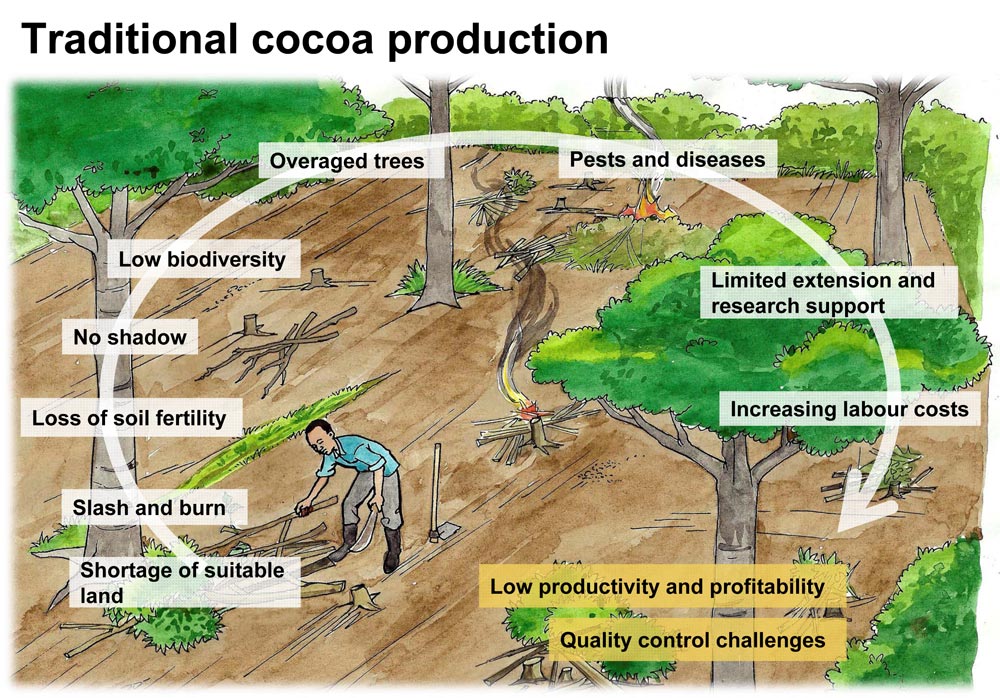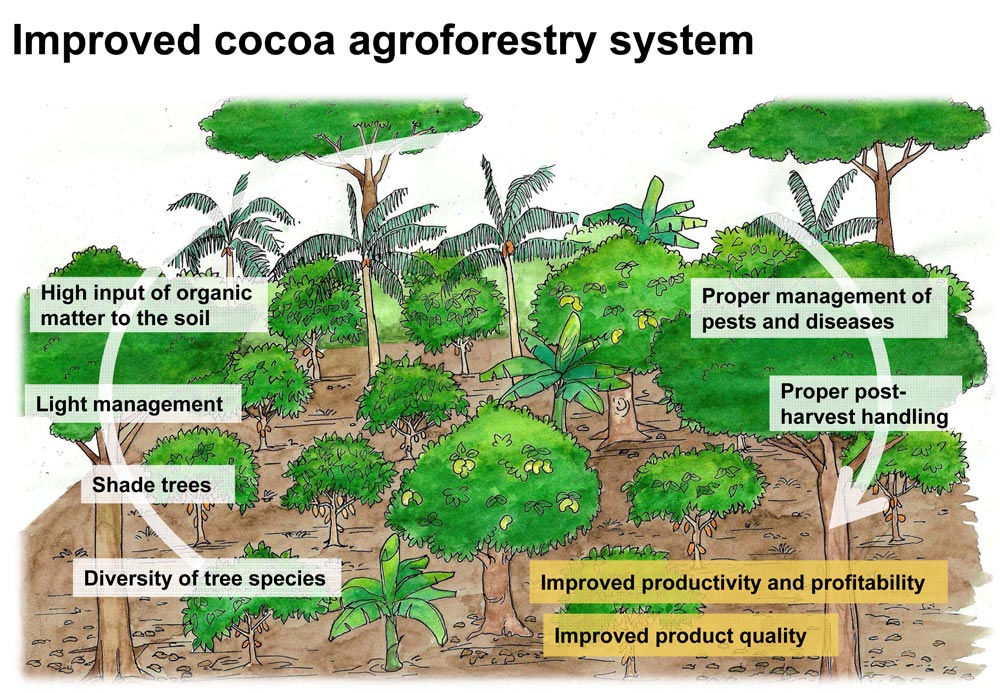Introduction

Cocoa (Theobroma cacao) plantations are one of the most important forms of land use and are of enormous economic importance to developing countries in the humid tropics. The main cocoa producing countries in Africa include Cameroon, Ivory Coast, Ghana and Nigeria in West Africa. Organic cocoa is mainly produced in Madagascar, Tanzania and Uganda. FAO reports that the world dry cocoa bean production has increased in the last 30 years from 1.54 to 4.16 million tonnes. To reach this total production, the world average yields in dry beans have increased from 350 kg per hectare to 500 kg per hectare during that time and the area under cocoa was substantially increased. However, the
International Cocoa Organisation reports that there are big differences in yields between regions. While farmers in West Africa attain yields of 200 to 300 kg per hectare, farmers in Latin America and Indonesia harvest between 500 and 600 kg of cocoa beans per hectare on average.
Common challenges facing cocoa production in Africa

- Limited extension and research support - Most cocoa in Africa is grown by small scale farmers, who are mostly relying on traditional production practices. There is limited or non-existent extension support, and improved production technologies often do not reach the farmers.
- Shortage of suitable land for expansion of cocoa production - Traditionally, primary forests, which have fertile soils and give a conducive forest environment for cocoa production, were often cut through the practice of slash and burn. Since forest land is no longer available as in the past, new cocoa plantations must be established on agricultural land. Additionally, laws and regulations limit access to natural resources in some countries. In some countries governments own all primary forests with timber trees. As a result, farmers are not motivated to protect them or to establish timber trees in their gardens since the land is not theirs.
- Low productivity and profitability of cocoa plantations - Many cocoa plantations in Africa are poorly managed and trees are overaged. In some cases, cocoa is grown in monocultures under largely unshaded conditions. Such a production system enhances loss of soil fertility and biodiversity. Poor soil fertility has led to poor growth and premature aging of the cocoa trees, and hence to low productivity. Unfavourable climate changes through irregular rainfall patterns and droughts have also contributed to increased stress for cocoa trees rendering the cocoa trees more susceptible to pest and diseases. Most cocoa farmers are experiencing low farmgate prices for their produce. Yet all input prices such as labour costs are increasing. There are increasing industry concerns about using child labour as a cheap source of labour.
- Quality control challenges - As a result of many factors including pest and disease damage, poor postharvest handling and limited processing infrastructure, the majority of the produced cocoa is of poor quality.
The diversification of cocoa plantations and the production of high quality cocoa beans are important strategies in order to improve the economic and social situation surrounding cocoa production.
The most important intervention today is to improve production of the existing cocoa plantations in order to minimize the continuous search for fertile soils in primary forests. This requires implementation of more diversified agroecosystems that satisfy the ecological requirements of the cocoa trees. Increased yields have been reported in organic cocoa cultivation, where a sustainable multistorey agroforestry system was properly established and is well managed. Additionally, a system based on high diversity holds enormous potential for environmental conservation in cocoa producing regions.
Recommended further reading
- FAO. Organic Cocoa Production: A guide for Farmer Field Schools in Sierra Leone. 2007. www.fao.org/fileadmin/templates/organicexports/docs/OrganicCocoa_FFS_Guide.pdf
- SIPPO, FiBL, Naturland. Market Overview on Coffee, Cocoa and Tea. 2002. www.sippo.ch > Publications > Food > Organic Food Products
- Naturland. Organic Farming in the Tropics and Subtropics: Cocoa. 2000. www. naturland.de/fileadmin/MDB/documents/Publication/English/cocoa.pdf
- Asare, Richard. Cocoa agroforests in West Africa. A look at activities on preferred trees in the farming systems. 2005. Forest and Landscape Denmark. Working Papers No. 6-2005. www.SL.kvl.dk
- EPOPA. The Organic Cocoa Market in Europe. Summary of a market study. 2003. www.epopa.info

Comments
Post a Comment